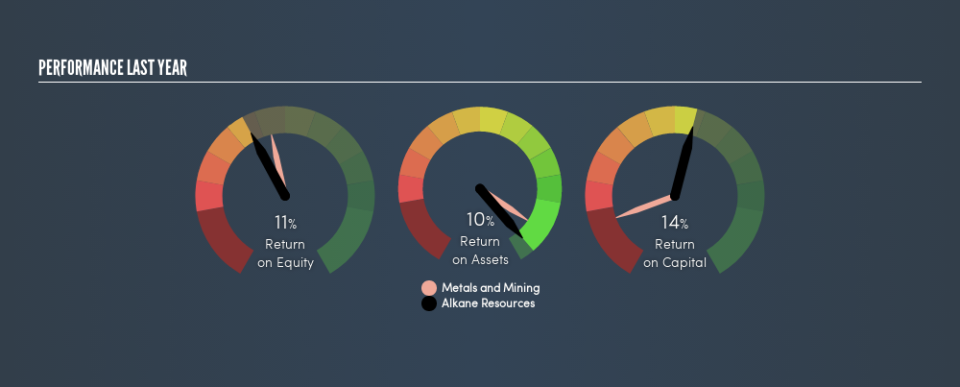Alkane Resources Limited (ASX:ALK) Earns Among The Best Returns In Its Industry

Today we'll look at Alkane Resources Limited (ASX:ALK) and reflect on its potential as an investment. To be precise, we'll consider its Return On Capital Employed (ROCE), as that will inform our view of the quality of the business.
First up, we'll look at what ROCE is and how we calculate it. Next, we'll compare it to others in its industry. Last but not least, we'll look at what impact its current liabilities have on its ROCE.
Return On Capital Employed (ROCE): What is it?
ROCE measures the amount of pre-tax profits a company can generate from the capital employed in its business. All else being equal, a better business will have a higher ROCE. Ultimately, it is a useful but imperfect metric. Renowned investment researcher Michael Mauboussin has suggested that a high ROCE can indicate that 'one dollar invested in the company generates value of more than one dollar'.
How Do You Calculate Return On Capital Employed?
Analysts use this formula to calculate return on capital employed:
Return on Capital Employed = Earnings Before Interest and Tax (EBIT) ÷ (Total Assets - Current Liabilities)
Or for Alkane Resources:
0.14 = AU$30m ÷ (AU$242m - AU$22m) (Based on the trailing twelve months to December 2018.)
Therefore, Alkane Resources has an ROCE of 14%.
See our latest analysis for Alkane Resources
Is Alkane Resources's ROCE Good?
One way to assess ROCE is to compare similar companies. Alkane Resources's ROCE appears to be substantially greater than the 9.1% average in the Metals and Mining industry. I think that's good to see, since it implies the company is better than other companies at making the most of its capital. Independently of how Alkane Resources compares to its industry, its ROCE in absolute terms appears decent, and the company may be worthy of closer investigation.
Alkane Resources delivered an ROCE of 14%, which is better than 3 years ago, as was making losses back then. This makes us wonder if the company is improving. You can click on the image below to see (in greater detail) how Alkane Resources's past growth compares to other companies.
It is important to remember that ROCE shows past performance, and is not necessarily predictive. ROCE can be deceptive for cyclical businesses, as returns can look incredible in boom times, and terribly low in downturns. ROCE is, after all, simply a snap shot of a single year. We note Alkane Resources could be considered a cyclical business. What happens in the future is pretty important for investors, so we have prepared a free report on analyst forecasts for Alkane Resources.
What Are Current Liabilities, And How Do They Affect Alkane Resources's ROCE?
Current liabilities include invoices, such as supplier payments, short-term debt, or a tax bill, that need to be paid within 12 months. The ROCE equation subtracts current liabilities from capital employed, so a company with a lot of current liabilities appears to have less capital employed, and a higher ROCE than otherwise. To counter this, investors can check if a company has high current liabilities relative to total assets.
Alkane Resources has total liabilities of AU$22m and total assets of AU$242m. As a result, its current liabilities are equal to approximately 8.9% of its total assets. Low current liabilities have only a minimal impact on Alkane Resources's ROCE, making its decent returns more credible.
Our Take On Alkane Resources's ROCE
If it is able to keep this up, Alkane Resources could be attractive. There might be better investments than Alkane Resources out there, but you will have to work hard to find them . These promising businesses with rapidly growing earnings might be right up your alley.
If you are like me, then you will not want to miss this free list of growing companies that insiders are buying.
We aim to bring you long-term focused research analysis driven by fundamental data. Note that our analysis may not factor in the latest price-sensitive company announcements or qualitative material.
If you spot an error that warrants correction, please contact the editor at editorial-team@simplywallst.com. This article by Simply Wall St is general in nature. It does not constitute a recommendation to buy or sell any stock, and does not take account of your objectives, or your financial situation. Simply Wall St has no position in the stocks mentioned. Thank you for reading.

 Yahoo Finance
Yahoo Finance 
